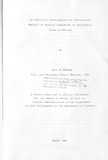| dc.description.abstract | In most urban areas, residential land use
takes up the -highest proportion of land. The
residential accommodation comprises flats, detached
and semi-detached houses on differing sizes of land.
The heterogeneity of this accommodation reflects not
only decisions taken by households at some time but
also diversity in income, family structure, tastes
and preferences as well as other socio-economic
characteristics of households.
Sociologists and city planners have used an
economic theory to contribute to the theory of
residential location which depends on the assumption
that as the population of a city grew and the housing
stock increased, the newest dwellings would always be
occupied by the high income groups and that as the
dwellings aged, they would filter down through the
population, becoming cheaper and cheaper and being
occupied successively by households of lower and
lower incomes. The pattern of location of households
with differing incomes would be determined by the
pattern of growth of the city in the past. Many of
these theories have concentrated upon institutional
analysis to the exclusion of the individual actor.
This study wishes to analyse the individual aspects
of residential mobility and preferences in the process
of residential location. The fact that residential
accommodation in different parts of Nairobi is
heterogeneous reflects not only that decisions are
made with reference to choice of acco~modation by
each household but also differences in income, capital
accumulation, family structure etc. of these households.
In making residential choices, households
do not make decisions in a vacuum, rather the
preferences that they express and the constraints
that they experience are moulded by the nature of
the wider social structure and by the immediate effects
of the specific character of certain systems of housing
production and allocation. This study sets out to
examine the factors responsible for the current
pattern of residential locations in Nairobi, more
specifically, to analyse the factors that households
consider in locating in a certain area and in a
particular house. This is therefore a study on
residential location based upon the survey, evaluation
and comparison of eleven (11) localities selected
from the metropolitan area of Nairobi, Kenya. These
localities represent the full range of residential
developments of Nairobi, planned and unplanned
neighbourhoods, lowest to highest densities and
lowest to highest incomes.
The results from the eleven residential
areas studied have revealed that although people
of all socia-economic levels aspire to good quality
housing with complementary facilities most people
want a satisfactory physical and social environment,
however, the degree to which this desire is satisfied
is strongly related to the socia-economic stage that
each house has reached. This study contends, that
the socia-economic status of a household influences
the choice of residential location. While lower
income households tend to make developed residential
location decisions which are influenced by such basic
aspects as space, rent and distance to work, higher
income households have more 'luxurious' factors such
as neighbourhood and better house designs. | en |

